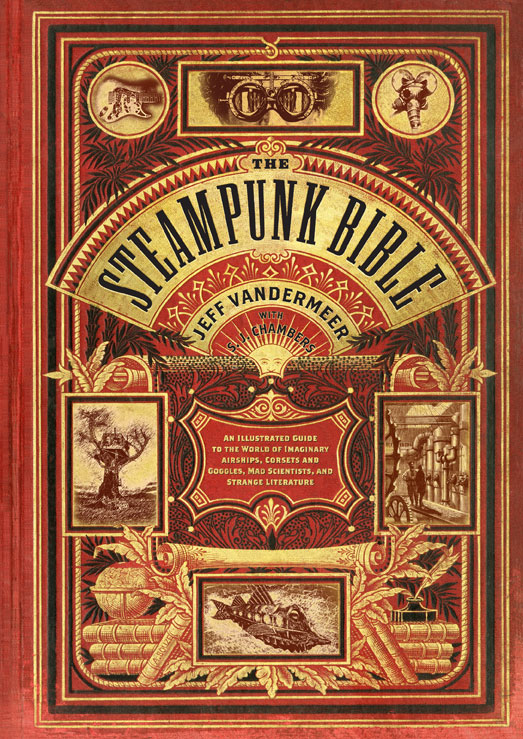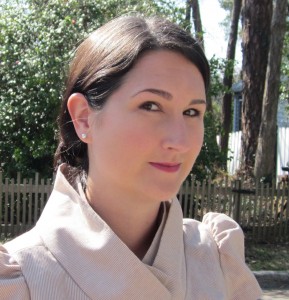The Steampunk Bible with Co-Writer S.J. Chambers
One of the best things I’ve discovered during my time with Nerd Caliber is the culture of Steampunk. The energy of the Steampunk movement hasn’t reached its peak, as attendance at conventions continue to grow and new conventions pop up across the world. I picked up the Steampunk Bible at the Steampunk World’s Fair to get better acquainted with the culture and I was not disappointed. Below is my interview with The Steampunk Bible co-writer S.J. Chambers where we talk about their book and where they see this movement heading. If you enjoyed our interview, please check below and watch some footage of the Steampunk Bible panel (filmed at the Steampunk World’s Fair), hosted by co-author S.J. Chambers with contributors Jake von Slatt, Ay-Leen The Peacemaker, Jaymee Goh, Ekaterina Sedia, Dr. Grymm and Margaret Killjoy.
#####

How did you (S.J. Chambers) and Jeff VanderMeer team up to produce this book? How did you become aware of the Steampunk culture?
I came to the book after Jeff had already sold it, and he needed a research assistant. He knew I had a background in Art History and nineteenth century art and literature, was adept at writing non-fiction, and that I was involved with science fiction and fantasy, so he thought perhaps I’d really enjoy working on a coffee table book about a nineteenth century inspired cultural movement. He was right, I fell in love with the movement and soon my research evolved into writing, and before I knew it, we were crafting a beautiful book together.
However, I was aware of Steampunk before Jeff approached me about it. I first became aware of the Steampunk culture when Newsweek ran a feature in 2007 about the movement. They featured Jake von Slatt and Datamancer, and their work was so striking and unique, it struck a chord with me. Here’s a link to that article if you are interested: http://www.newsweek.com/2007/
2) In your book, you describe how Steampunk has its roots in classic literature from Jules Verne’s and H. G. Wells to the more modern works of K. W. Jeter. How do you think Steampunk culture has suddenly become so popular in a modern world where television and the internet are so influential?
In a book, there are no constraints like a special effects budget and revealing plotlines before the commercial, so the imagination can run as wild as it likes—build the craziest machines, design the most outlandish costumes, develop complicated characters, and build worlds with complex political and philosophical systems. Of course, movies and television can accomplish similar feats, but I feel like a book gives so much more context, and is usually more liberal in that context. I think this works in Steampunk writers’ favor, and is why it really appeals to its readers who want to know more about that world, that time, and those characters.
The Steampunk Bible discusses a broad range of art forms that Steampunk is influencing, from music to fashion. What chapters do you think would surprise Steampunk enthusiasts to discover? Why? Which chapter was the most fun to discover and write?
Well, I would like to think there is something new to discover in each chapter, but I would have to say that the Origins chapter, as well as the Art and Maker chapter, might hold the most surprises for enthusiasts. In the Origins chapter, a big picture of Steampunk as a literary movement is drawn and traces back to the origins of science fiction writing, with the idea of the philosophical story, and the hoaxes of Edgar Allan Poe. All too often, only Verne and Wells are pointed to as the progenitors of Steampunk, but they would not have written what they did, and how they did, without Poe’s influence.
The Art and Maker chapter was also a lot of fun for a similar reason. Enthusiasts may not realize how closely Steampunk parallels its Arts and Crafts ancestors—but both movements brace themselves against a homogenizing society. During the Arts and Crafts era, when Industrialization was threatening the livelihood of artisans, there was a revolt against work factory furniture. Artists began to form guilds and to build hugely ornate and uniquely functional works of art that a machine could never manufacture. They were, in essence, reclaiming their humanity through their furniture. Steampunk is having a similar battle with technology. Our technology today is too enabling, too facile. It takes away physical and mental challenge. Steampunks who are making their own clothes, building archaic contraptions, etc. are doing so out of a desire to understand how things work, to have a say in the matter, and to keep alive the human touch.

Spiritual life was very strong in the 1800’s, with new religions springing forth as well as a fascination with the supernatural. Do you think religion and spirituality has a place in Steampunk culture? How so?
I think there could be a lot of interesting discussions had about that, especially when you take into consideration that a lot of those supernatural and spiritual movements were considered “scientific”—like Mesmerism. There was also a big concern among Victorians and their U.S. cousins that science was out to eradicate religion, if not replace it. Those same concerns are resonant today as we contemplate Transhumanism and cloning, so the “backward glance” to nineteenth centuries Positivist and Spiritualist concerns would open a wonderful dialogue for us in the 21st century who are still concerned about what and where the soul is, and where it goes when we’re gone.
The art and photographs displayed in The Steampunk Bible are beautiful. How was the unique look of the book brought together? What were your challenges?
Well, the overall theme of the book was designed by Abrams graphic designer: Galen Smith. Jeff approached him with the idea of having the cover look like an old Jules Verne Hetzel cover, and the effects Galen conjured throughout the book is just wonderful. As for the images themselves, Jeff and I, and our wonderful editor Caitlin Kenney, went through several passes of the book to make sure each image matched up with the text, and complimented other images, etc. There was a bit of rearranging and cutting, but at one point serendipity kicked in and everything fit together.
What is currently happening with Steampunk that has you excited?
I am really excited about the International movements. I really like seeing the different spins groups like Brazilian Steampunk and French Steampunk are taking on the movement. There is so much energy, and in the case of Brazilian Steampunk, really great writing being written, and in French Steampunk stunning art is being made. I’m really excited to be going to Paris in September, where I’ll be doing a Steampunk Bible event with the French Steampunks. It should be a lot of fun.

Where do you see Steampunk heading ten years from now?
It is hard to say whether people will still be dressing Steampunk, and whether there will be conventions, but I do think Steampunk will be around in ten years. I think it is well on its way—in literature and art at least—of becoming a style. Just like artists can choose to paint in the Impressionist style, or writers choose to write an imagist poem, Steampunk’s aesthetics and issues will transcend into a style artists and writers will use to the better advantage of what they are creating. I think what is Steampunk style is still being defined, but I bet will be realized fully in ten years.
Do you both have any steampunk-related projects coming up that might interest those that enjoyed The Steampunk Bible? Are there websites readers can find out more information about your works?
Yes. I am currently editing and writing the sister website for The Steampunk Bible, which can be found at www.steampunkbible.com. Over the next few months, there, I will be posting extra content, like raw interviews, the Steampunk Bible Index, and unpublished images. There will also be new content coming from people in the community, for instance Josh Pfieffer is coordinating a music special for us, and should be fun times. I am also gearing up to go on the second leg of The Steampunk Bible tour, where I will be having events in London and Paris in September. People can find out more information about those dates and events at my website: www.sjchambers.org, or can follow me on Twitter, where my handle is @selena_jo.
On the fiction writing front, I have a short story called “Dr. Lambshead’s Dark Room” in Ann and Jeff VanderMeers’ latest anthology The Thackerty T. Lamshead’s Cabinet of Curiosities. This isn’t a pure Steampunk anthology, but the inclusion of Steampunk writers and artists like Jake von Slatt and Cherie Priest, as well as the element of imaginary artifacts and the lost tradition of the curiosity cabinet, should be appealing to the Steampunk crowd.
#####




Woah! I’m really loving the template/theme of this site. It’s simple, yet effective. A lot of times it’s tough to get that “perfect balance” between user friendliness and appearance. I must say you’ve done a awesome job with this. In addition, the blog loads super quick for me on Firefox. Outstanding Blog!